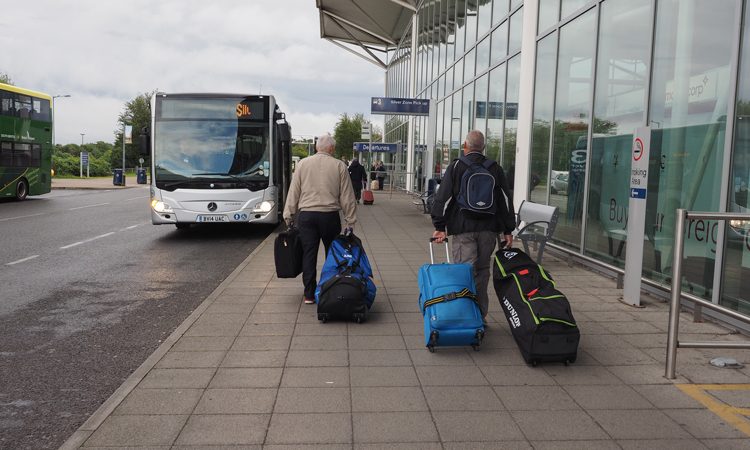Bristol Airport buses: saving time, money and keeping passengers on the move
- Like
- Digg
- Del
- Tumblr
- VKontakte
- Buffer
- Love This
- Odnoklassniki
- Meneame
- Blogger
- Amazon
- Yahoo Mail
- Gmail
- AOL
- Newsvine
- HackerNews
- Evernote
- MySpace
- Mail.ru
- Viadeo
- Line
- Comments
- Yummly
- SMS
- Viber
- Telegram
- Subscribe
- Skype
- Facebook Messenger
- Kakao
- LiveJournal
- Yammer
- Edgar
- Fintel
- Mix
- Instapaper
- Copy Link
Posted: 6 September 2018 | Martin Fisher - Bristol Airport | No comments yet
Bristol Airport’s Motor Transport Manager, Martin Fisher, explains the various benefits that stemmed from installing surveillance technology on the airport’s bus fleet.


Located eight miles south of the city of Bristol and serving over 9 million passengers per year, Bristol Airport is one of the UK’s fastest growing regional airports. It is also one of the most efficient – the organisation is immensely proud of being named the most punctual in the world in 2014, and in 2018 came joint first for the 5-10 million category at the Airports Council International Awards.
So when it became clear that an opportunity existed to further improve the efficient and safe flow of passengers, the Transport Management team jumped at the chance. The opportunity in question? Using surveillance technology on the airport’s bus fleet.
Better bus surveillance, better business
Unlike many airports that are solely served by external bus operators, Bristol Airport runs their own fleet of 11 Mercedes-Benz Citaro vehicles, including Citaro G articulated or ‘bendy’ buses, to help transport passengers between car parks and the terminal efficiently and safely.
These buses feature luggage racking, a driver microphone/speaker system and LED destination displays with interior display screens showing important passenger information to ensure a smooth transition from the bus to the terminal. Now, they also incorporate surveillance solutions, comprising high-quality recording equipment integrated with telematics and cameras (internal and external). This addition is making quite a difference.
Keeping an efficient passenger flow
If you don’t keep buses moving efficiently around the airport, it causes unnecessary hold-ups and disruption to passengers, and that’s bad for business.
Having on-vehicle surveillance helps us avoid this in several ways, even down to how we train new drivers. For example, footage and telematics data from the buses, driver activity, driving style and completed manoeuvres can all be analysed to ensure the buses are being driven optimally. It’s worth remembering that these drivers have to operate in pretty confined and busy areas so it’s helpful to be able to fine-tune performance.
Safety – review, predict, prevent
As the fifth busiest airport in the UK outside London, another issue we have is traffic. In addition to receiving local bus services from Bristol and Weston-super-Mare, multiple bus operators from outside the area also have regular routes to the airport from locations including Swansea, Plymouth and Bath. Combined with taxis, passenger drop-offs and collections and passenger parking, at peak times it’s an extremely busy transport hub for the area.
Before we had the on-board vehicle surveillance, we had no visual record of how any incidents involving vehicles could have occurred or how to prevent similar incidents in the future. Now, this is not a problem. Having the capability has helped improve safety and efficiency for passengers, staff and drivers.
We also currently operate 12 Cobus 3000 airside buses and have the Synectics system fitted to one of the newest vehicles on a long-term test to ensure it brings the same (and additional) benefits. For instance, as well as aiding drivers navigating the busy airside road system – showing rear view cameras when reverse gear is selected – on-board cameras for these airside vehicles also help monitor passenger safety, comfort and wellbeing, alerting drivers if any problems or medical emergencies occur.
Improvements by design
We also use our surveillance resource as a business tool to support a broader range of safety, security and operational objectives. Understanding how and where infrastructure layout might be further optimised to promote greater efficiencies is one such objective.
By reviewing the footage from external cameras, for example, to see why there have been delays or damage to the vehicles, we can identify any problem areas or incident hot spots. An example of this is where an existing parking layout might be making life difficult for our bus drivers. Once aware, we can make the necessary changes to make sure everything flows smoothly.
Surveillance support that makes life simpler
Of course, using technology in this way is not a solo project. A key reason we’ve been able to implement changes so efficiently is the relationship we’ve developed with our surveillance solutions provider, Synectics. For each new Citaro we receive, we know they will work with Mercedes and EvoBus GmbH to ensure the solutions we need are factory fitted to specification, but we also know that we can call on them to retrofit where required, as is the case with our airside Cobus 3000 vehicles.
They also really listen to our needs. For example, with such minimal drive times, we haven’t yet felt the need to adopt Wi-Fi on our vehicles, which would allow us to transmit data wirelessly. So rather than sell us a solution that doesn’t meet our current needs, they developed the best possible solution while still making sure we are prepared for the future as our requirements develop. With any technology adoption, this type of support is vital.
Related topics
Fleet Management & Maintenance
Related modes
Bus & Coach
Related cities
Bristol, United Kingdom
Related organisations
Bristol Airport
Related people
Martin Fisher








